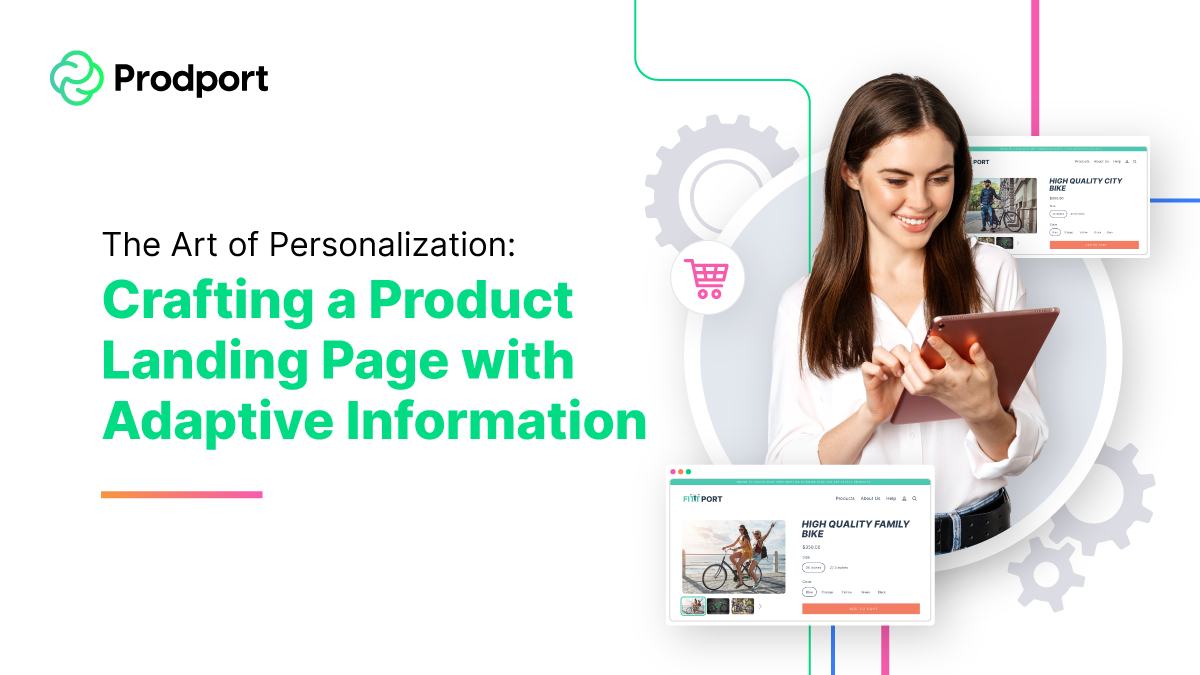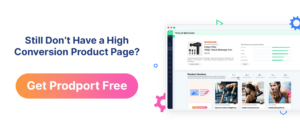Based on recent studies, one can conclude – personalization on product landing pages is far from expectations, and the customers don’t see it the same way the brands do.
Then, it’s fair to say that well-implemented personalization practices in e-commerce are more of an exception than a rule.
And this is an opportunity that you should not pass up.
In this guide, you’ll learn why it’s so important to personalize product landing pages and how adaptive information can make all the difference. All that, along with actionable tips and product landing page examples to implement on your ecommerce store.
What is a product landing page?
A product landing page is a post-click page with one main goal – to sell or promote a particular product. It’s no different in web design from the usual landing pages. Its content relates directly to the single product offer, leading potential customers directly to conversion.
Why personalized product landing page rules?
Personalization has become more than just an optional extra on product landing pages. It is a make-or-break factor. As 73% of customers stated, it impacts the final purchase decision. According to the McKinsey report, its lack can lead to frustration and doubt.
💡 If you tailor the web page content to the specific needs of your shoppers, you create a seamless and intuitive customer journey. Then your landing page viewers won’t have trouble finding exactly what they’re looking for.
Adaptive information as a key element of well-designed personalized product landing pages
Adjusting the product landing page design to the user’s screen and mobile devices is an essential UX design practice. But how would it be if you could tailor key elements of the landing page specifically to each potential buyer? Almost as if the product speaks directly to a particular prospect.
This is what adaptive product information does.
What is adaptive product information?
Adaptive information on the product landing page is the element, such as headings, product descriptions, images, or banners, that dynamically change according to the customers’ needs or current behavior.
Why does adaptive product information work?
Adaptive product information shows that you take care of every detail. This level of attention you pay to your product landing page can significantly impact your customers’ decisions. The greater the chance your product catches the customers’ attention, the more likely they will buy it.
Adaptive product information aims to deliver the right content to the right user in the right context.
🚀 Example: Suppose you have a beauty shop store and that your customer is looking for cream and a serum. You can bump them with the contextual message, e.g., that they can use the serum under the cream to boost its effectiveness on the skin. What’s the result? The consumer gets the personalized information that triggers a desire to buy both products and benefits from the best skin care. You get a higher basket value.
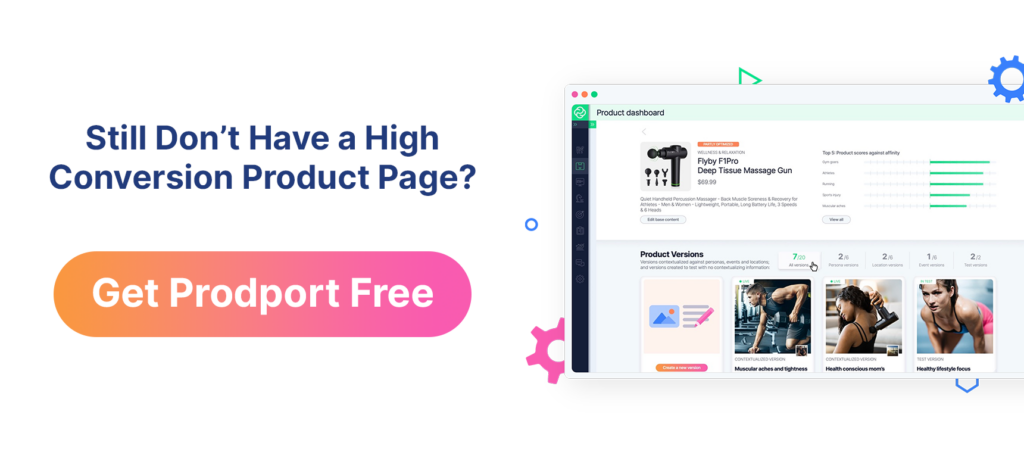 Adaptive product landing page example
Adaptive product landing page example
After implementing adaptive features on their product landing pages, Kahlmi, the world’s first baby massager, noted a 30% higher conversion rate. Their customers struggle with various problems, so they wanted to adapt the content to the different parents’ needs.
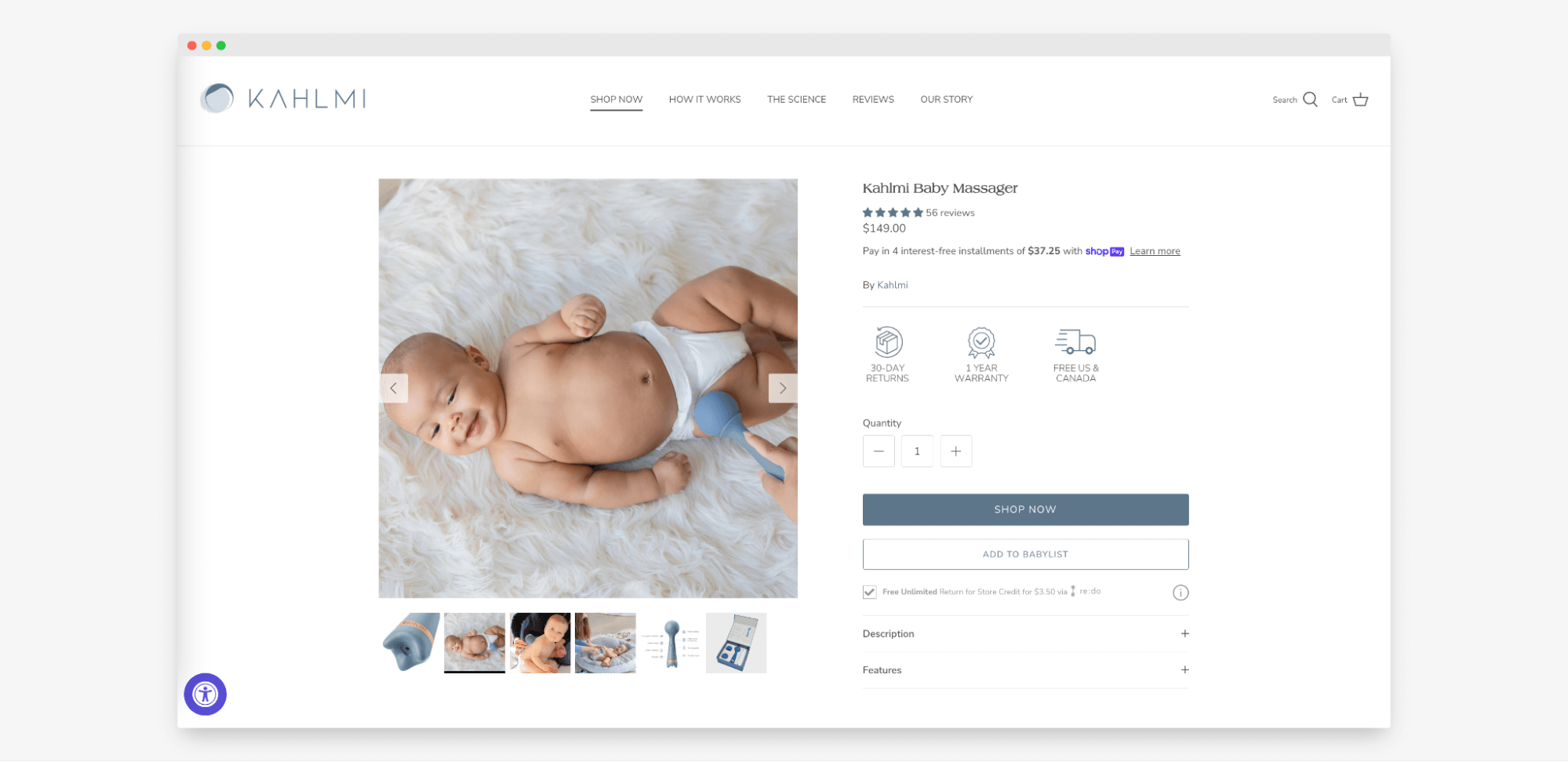
Source: kahlmi.com
Using the Prodport Shopify plug-in, the store prepared different versions of product landing pages for different incoming traffic. Thanks to that, they could maximize the potential of various elements on more sales.
➡️ See the whole Kahlmi case study.
4 other elements to personalize your product landing page design with adaptive information
However, a product landing page is a coherent whole. In a sense, it is like a smooth system in which all elements work together to convert prospects into customers. So, to maximize adaptive information potential, you have to take care of the rest of the design principles.
Here are the most vital landing page elements you can optimize through adaptive information.
#1 Compelling landing page headline that matches user search intent
The headline is the first thing visitors see when they land on your page.
And you have only about 8 seconds to prove that your product is worth their time.
(🫡 You deserve congratulation for lingering a little longer on this article here).
Create a problem-focused headline around the primary keyword, depending on your target buyer persona. Use some creativity with persuasive words to make up a click-worthy message.
In short, apply these proven headline-writing rules:
- Use the 3S method: Secret, Superlative, and Scary – revealing the unknown, describing “the best” or “the worst,” and stimulating curiosity.
- Keep it short and to the point.
- Focus on strong keywords that describe your product well and resonate with a particular group of prospective customers.
- Create a landing page headline that drives emotional response.
- Don’t use generic terms that could apply to many product landing pages. Your product is unique. Show it.
Tip: Align your headline with the user’s search intent to maximize its potential. With Prodport, you can do that without coding skills. You set up a few product landing page versions – Prodport and its algorithms take care of the rest.
Why do headlines work?
A bold headline is a bait to attract direct visitors to explore your product landing page further. It gives prospects a quick introduction to your product and what it’s all about.
See the headline example on the digital product landing page example in action
Recess, and its “We canned a feeling,” is a creative product landing page example of a headline conveying a core product message. The visitors get two different landing page versions depending on the product flavor.

The product and its headline complement each other effectively. Recess clarifies that its beverages give the customers calm and harmony or an energy boost, depending on the particular customers’ needs.

Source: takearecess.com
These headlines grasp the viewer’s attention and successively lead to signing up for a subscription service.
#2 Product descriptions that cover every pain point
It’s not all about product characteristics.
A good product landing page focuses on the product’s benefits rather than its key features.
However, the best ones adjust these benefits to the visitors.
Yes, you’ve got it right. It’s possible to adjust the landing page copy and product details to the particular user.
But, still – quality over quantity. That’s why, before crafting different product description versions, keep these tips in mind.
- Make your description more readable by separating some elements with white space.
- Use short paragraphs that highlight only the most vital information.
- Push product benefits, not product’s features.
- Put your focus on a few key differences that set your product apart from the competition.
- Take advantage of customer testimonials and positive customer reviews and include them next to the description section on the product landing page.
Why do adaptive product descriptions work?
Simple truth. Your product landing page description affects how well you communicate with your clients.
So, whether you’re selling software, online courses, or digital products, it all boils down to one crucial factor – the value your product gives to its target market.
Product descriptions can be more effective if you adjust them to your prospects’ particular challenges. It will help them visualize how the product can benefit them.
See the adaptive product description in action on the stellar product landing page example
The Kanopi online store, a leading manufacturer of ceiling products, created different landing pages for its products based on its analysis of incoming traffic. Thanks to that, they can provide remarkable product landing page experience, tailor-made to the customers.
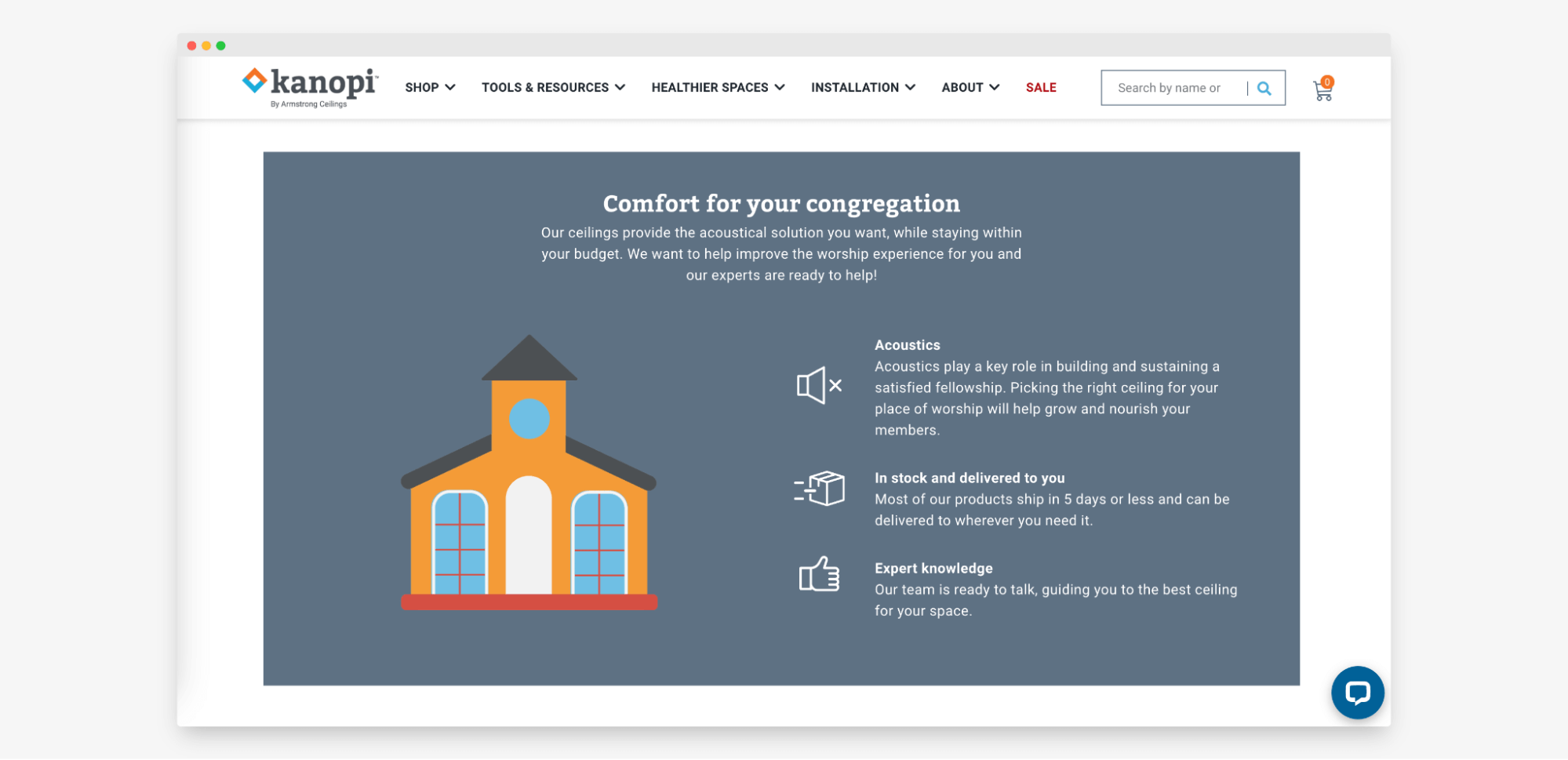
And so, depending on the industry – healthcare, restaurants, education, retail, churches – all get different highlights of product features and benefits.
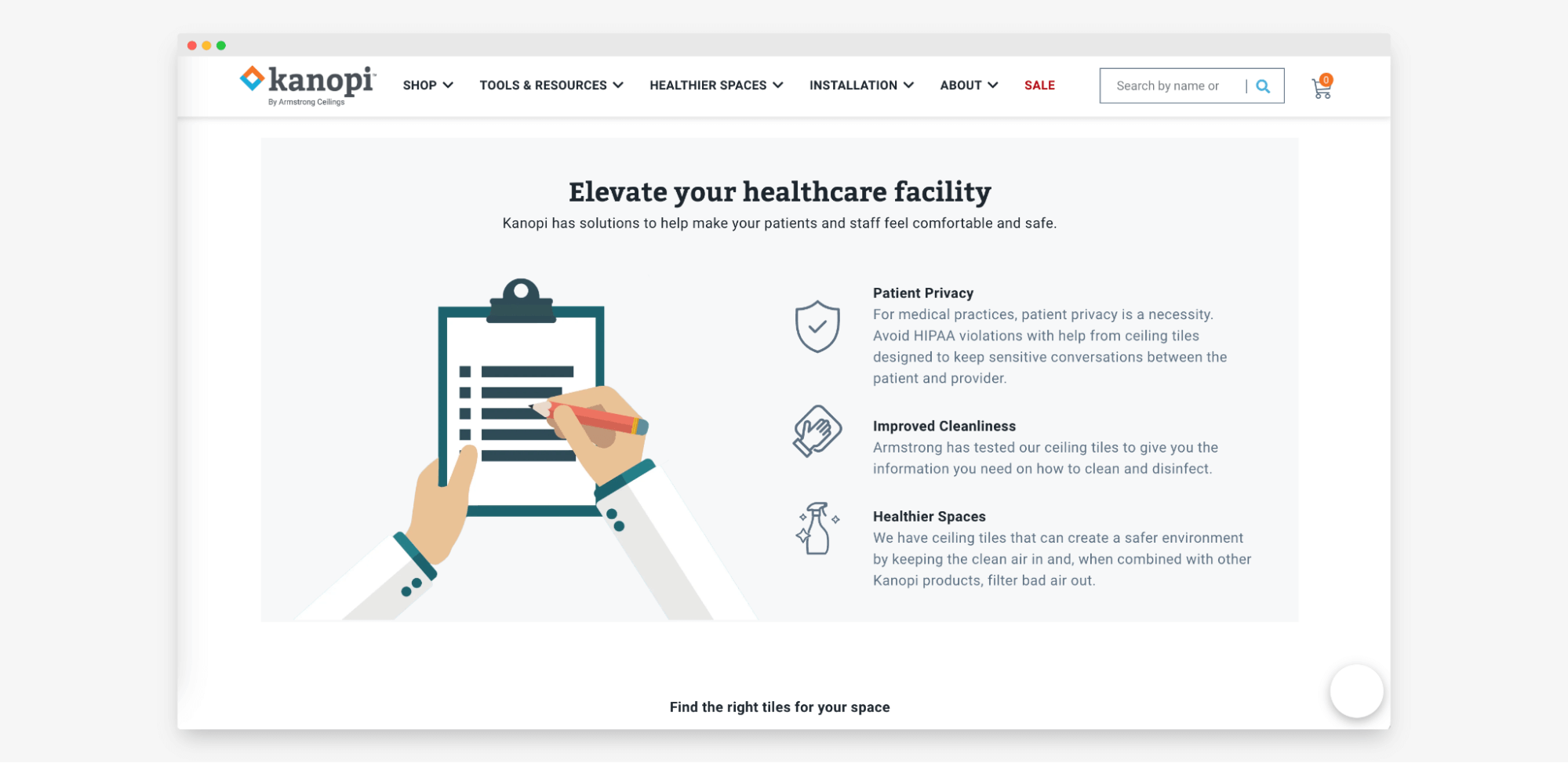
Source: kanopibyarmstrong.com
#3 Targeted offers and discount codes that show your customers how unique they are
People don’t like when something is missing them out. And they love saving money. The same goes for your customers.
Make them want to buy your product by giving them these “kicks.”
Adapt the discount code to the context. You’ll make the customer feel like it’s a special occasion that rarely happens. And if they don’t use it, it won’t happen again.
Here are the most common types of discount codes:
- Abandoned cart coupon code – 70% of people abandon their carts, push them away from this idea with a discount code.
- First-time shopper offer – welcome your customer on your product landing page and give them a reason to stay longer.
- Exit-intent offer – is a last chance to bring your customer back before they leave your store.
- Bundle coupons – a discount for a set of products or combos.
Why do adaptive discount codes work?
A coupon code influences customers to buy a product. This purchase incentive can be a decisive factor if they hesitate to buy a product. The best product landing pages use adaptive promo codes that can work even harder on potential buyers.
See the promo code in action on the dedicated product landing page example
Chirp is an example of a brand’s product landing page that, along with high-quality product images, uses adaptive elements to a great extent.
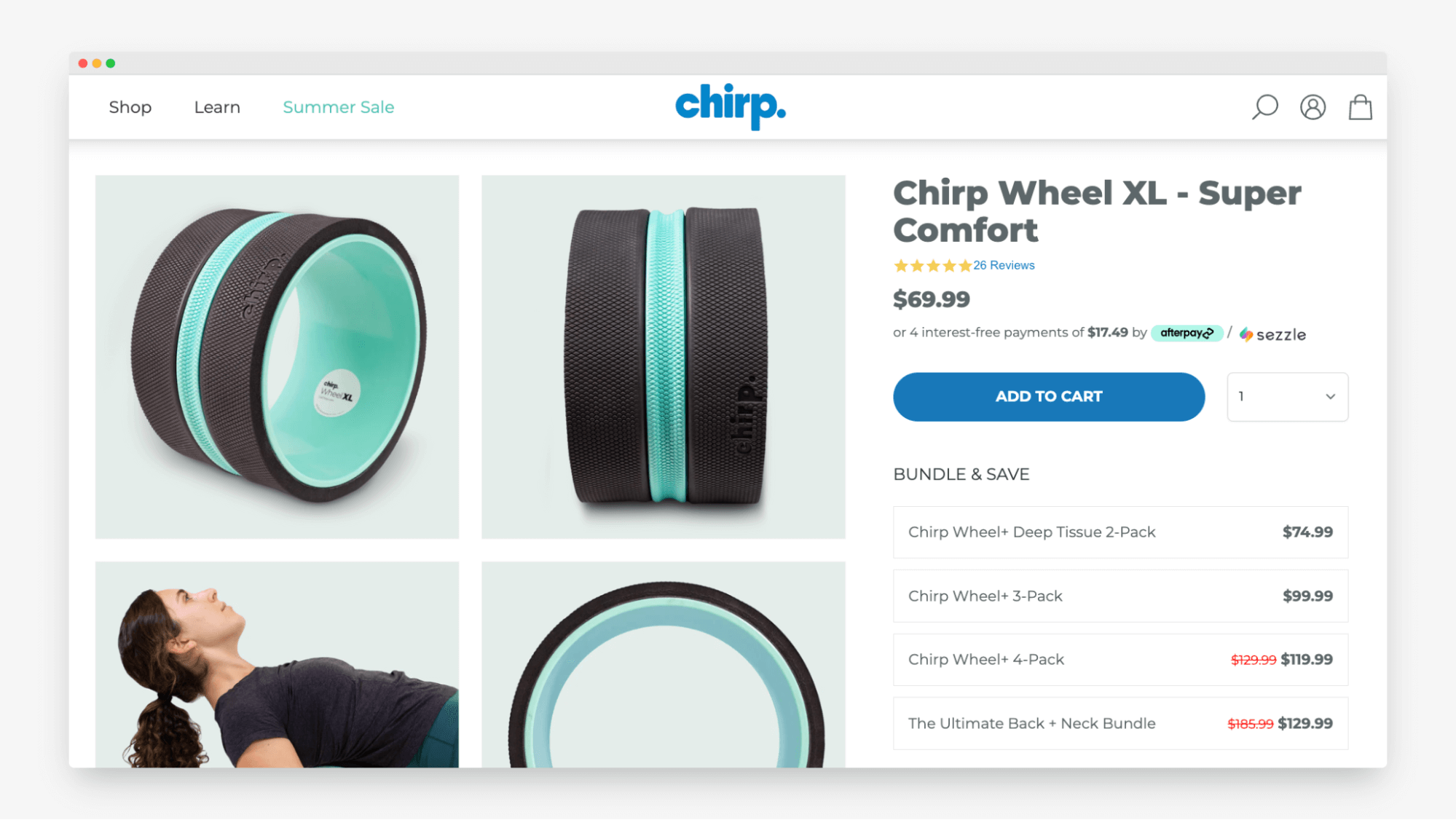
Source: gochirp.com
Below the CTA button to add the product to the cart, Chirp placed bundle coupons that customers can use when purchasing back relief tools. This and other adaptive landing page solutions, integrated with Prodport, allow for an almost 37% increase in the “add to cart” ratio.
#4 User-generated content to make your product real
When customers see every corner of your product page as a sales pitch, it can be hard to generate trust.
One subtle way, which doesn’t draw too much attention to your brand, is to use User Generated Content (UGC) instead.
Where can you find UGC for your product landing pages?
- Check popular social media platforms like Instagram, Twitter, etc.
- Explore review websites where users often share their experiences and opinions.
- Look for relevant forums and online communities where people discuss topics related to your product.
- Monitor hashtags and mentions of your brand or product across social media platforms.
- Use feedback channels like customer support emails, live chats, or customer satisfaction surveys.
Why does user-generated content work?
A customer testimonial, social media posts, combined with full-width images, can be a superior way to show your products in the best light possible in real-life situations. They serve as social proof that builds confidence that the solution works well and can solve their problems.
See the adaptive UGC in action on the physical product landing page example
WEAT on its product pages use section with the hashtag #WhoWoreWeat. It’s an adaptive UGC element that shows the exact product on high-quality images taken by real users.
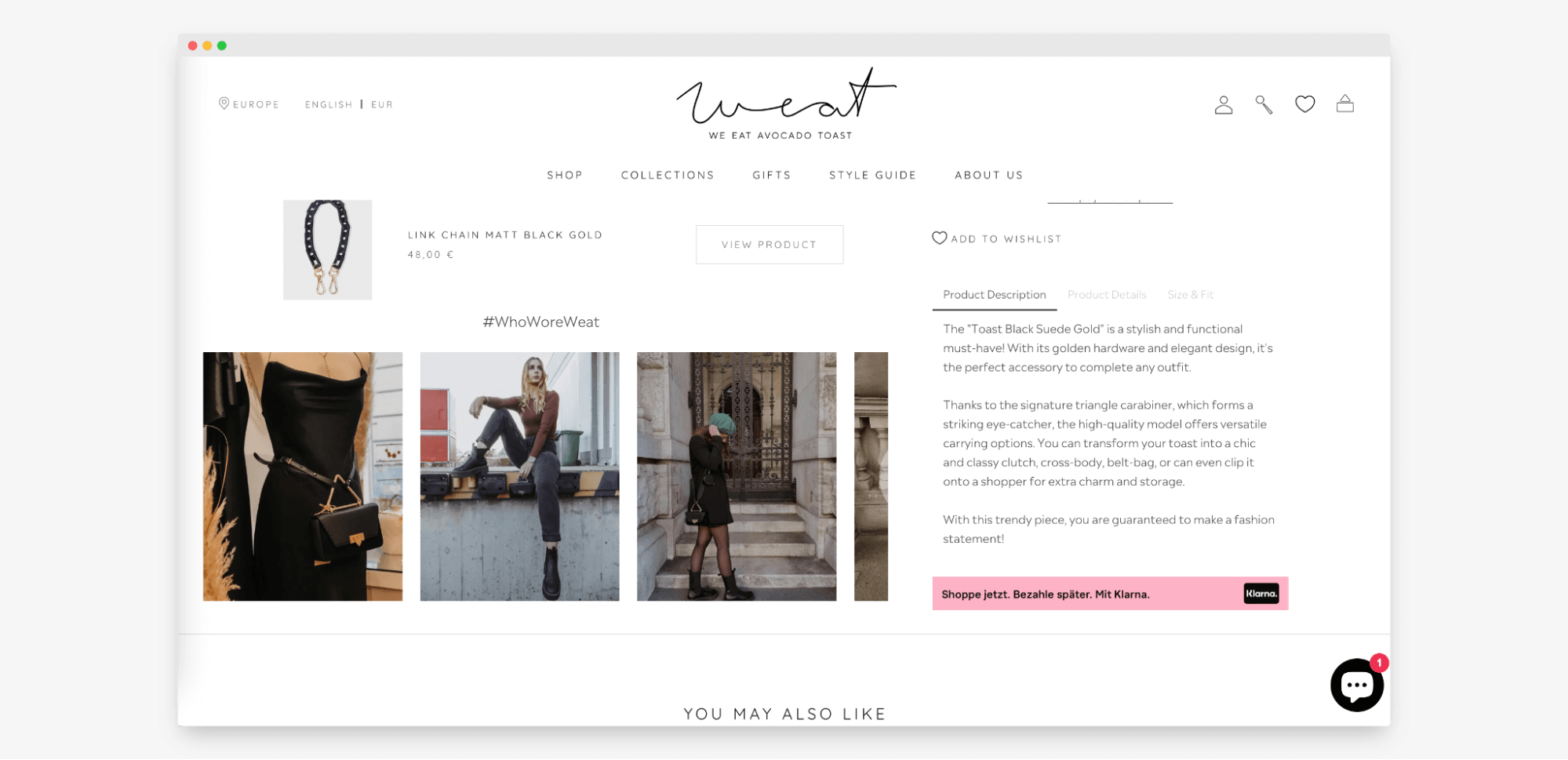
Source: weat-studio.com
Potential customers can see the physical products on outfits examples and decide whether it suits their style. Integrating the component with the Prodport plugin allows UX designers to display styling suggestions based on target group segmentation, such as travelers.
Pro tip: Integrate Prodport to boost the product landing page conversion rate
All these above should point you to one simple conclusion – “My product landing page needs adaptive components right now”.
And we couldn’t agree more!
A product landing page with personalized components gives your site a more emotional response. That’s what Prodport helps you do.
Prodport allows you to design product landing pages that behave as if they are reading the minds of your customers and responding to their needs.
Test, set your product pages to repeat visitors, add contextual messaging, offer custom-made promotions, and create better paid ads – all of that under one simple Prodport interface.
So if you want to create the best product landing page, don’t wait longer and try out the Prodport Shopify plugin. Your Shopify store address, email address, and name are all you need to get started!
Adaptive product information = personalized landing page
Every detail counts in creating a remarkable product landing page with well-implemented personalization. With the adaptive information component, you can be confident that your landing page copy is always tailored to your users’ interests.
In any case, it’s worth the effort – you give the potential customers experience they expect, leading to higher conversion rates.
Use the Prodport Shopify plugin today, get started for free, and easily create a successful product landing page. No-code adaptive components that drive your sales high!
